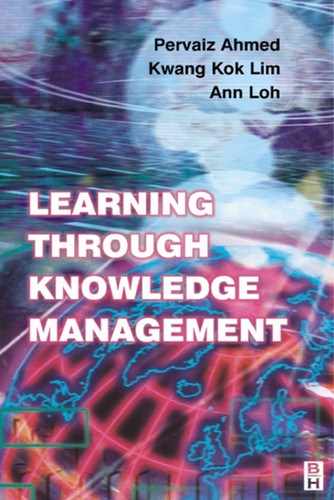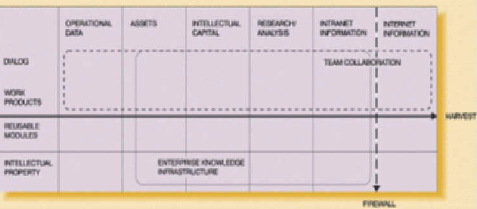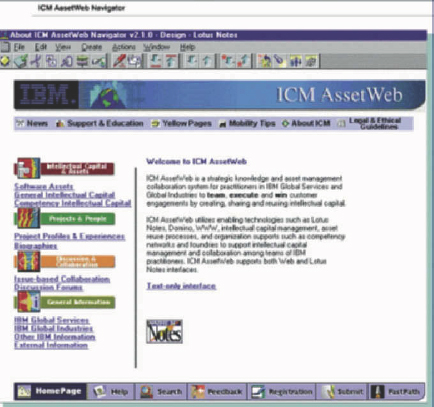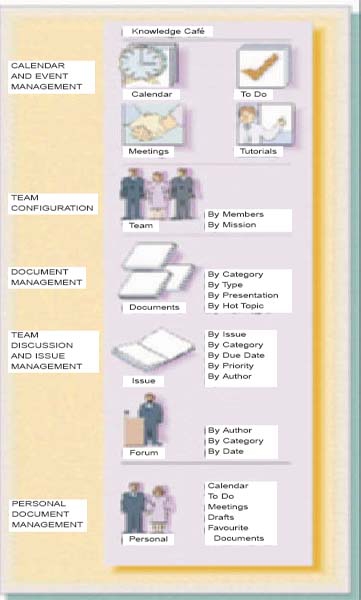15
IBM
In the late 1980s, Peter Drucker predicted that in the future the factory will be organized around information rather than automation . Today, companies like IBM have made this a reality.
The modern world is changing fast. Markets are now global and information intensive. To survive and prosper in this environment companies have renewed emphasis on four fundamental drivers of change: innovation, responsiveness, productivity and competency. These present demanding challenges, yet also open up a wealth of new possibilities. Success demands a capability to turn these market dynamics to corporate advantage.
The advent of new technologies, especially high-capability intranet technologies, has made possible collaboration at such levels as to enable rapid movement from customer needs identification to value delivery. These new capabilities have broken functional boundaries, which hitherto hindered the capacity to tap into the corporate wellsprings of knowledge.
In this era of the knowledge-intensive economy, corporations have rapidly come to realize the importance of configuring and capitalizing on their intellectual assets. Astute companies understand that infrastructure alone no longer suffices. The capacity to learn, collaborate and innovate faster than one's competitors is now a fundamental source for sustaining competitive advantage. The goal of managing knowledge is not only to seek short-term returns but to develop long-term strategic advantage over competitors.
IBM perspective on knowledge
Business organization can be defined in terms of three broad interlinked cycle-sets of activities: business management, project management and intellectual capital management. Each set has its own goals, processes, roles, constraints and types of information that can be manipulated for operational functioning. IBM categorizes these activities into six information or knowledge areas (Figure 15.1): operational data from business management, assets, intellectual capital, research and analysis, intranet information and Internet information. All these sets of activities are driven by information and knowledge. In this perspective, work products and deliverables are artefacts derived from projects. They are documented records of knowledge, generated by project teams. These tangible items are building blocks for knowledge sharing. Knowledge and information can be ‘harvested’ from projects and transferred into the wider organization through the company's enterprise knowledge infrastructure.
IBM has four major processes for knowledge sharing and collaboration:
- making knowledge visible
- increasing knowledge intensity
- building knowledge infrastructure
- developing a knowledge culture.
IBM's approach is to embed these knowledge processes into the fabric of IBM's business operations. In line with this comprehension, IBM explicitly attempts to address both cultural and technical issues. Increasing knowledge intensity and addressing cultural change are two of the most pressing issues faced by IBM.
Fig. 15.1 Categories of information and knowledge. Source: Huang (1988)
Fig. 15.2 Knowledge dimensions and intellectual capital ‘sweet spot’. Source: Huang (1988)
IBM believes knowledge transmission primarily occurs through human interaction and social processes. Knowledge transfer is effected most efficiently in a mutually dependent community. Knowledge management is classified along two dimensions (Figure 15.2):
- Dimension 1 – knowledge type, which ranges from tacit knowledge, through project experiences, to explicit knowledge.
- Dimension 2 – knowledge communities, which moves from individuals, through teams and groups, to enterprise organizations.
Within this categorization IBM sees the team or group environment as the ‘sweet spot’ for sharing both tacit and explicit knowledge. Frequent dialogues and discussions among the team members generate a wellspring of tacit knowledge. Such forums along with work products form the tacit knowledge base. These are the sources for collecting and recording explicit knowledge. To achieve good transfer, however, the team must have a shared sense of mission and clearly identified goals. Clarity and cohesion is needed for the team to be able to intensively generate knowledge.
Ultimately, IBM's approach is based on the premise that collaboration is the process of shared creation. Shared creation is at the heart of the generation, use and reuse of knowledge and assets.
The knowledge vision
IBM is an intellectual capital-intensive company and knowledge management has come to be a core activity in its business. Chairman and CEO, Lou Gerstner, in the 1997 IBM Annual Report, wrote, ‘behind the scenes we've been re-engineering IBM from top to bottom, with one goal: to foster a high-performance culture and turn IBM into the world's premier knowledge management company’.
IBM's knowledge management programme, ‘Intellectual Capital Management’ (ICM), was implemented in response to pressures for greater agility, innovation and responsiveness to the demands of customers. The driving force behind the original initiative was IBM Global Services, who set themselves the task of transforming themselves ‘from big iron to big intellects’ . IBM Global Services started its ICM programme in 1994. The aim was to strengthen intellectual capital and asset reuse within consulting engagement teams. The rationale behind ICM was to institutionalize and formalize knowledge management. The ICM project established a foundation for knowledge sharing and reuse at IBM. Lou Gerstner directed the efforts of the business challenge by asserting, ‘We have to win through brilliant execution that can only be done with teamwork’. His words have subsequently defined the three fundamentals of IBM's knowledge management effort: teamwork, execution and winning.
IBM's knowledge approach
IBM has worked hard to develop solutions and methodologies, and then meld them with technology. This has allowed it to manage, share and reuse its intellectual capital in a networked team environment. To increase knowledge intensity, IBM constantly sought to develop practical solutions to support team interaction, knowledge synthesis and infrastructural platforms. IBM has created solutions by closely attuning to user requirements, and deployed these worldwide through its computing infrastructure. These solutions are based on Lotus Notes Domino. the IBM intranet, e-mail, and linked telephone systems. Some of these technologies are very new, and IBM continues to work toward global implementation. These tools have helped IBM transform its business to a knowledge-based organization.
The major tools underpinning IBM knowledge management initiatives are:
- The ICM AssetWeb, which provides an enterprise knowledge infrastructure
- Knowledge Café, for team dialogue and collaboration
- Knowledge Cockpit, for business intelligence and knowledge discovery.
The ICM AssetWeb
The ICM AssetWeb provides the infrastructure for IBM's knowledge management solutions. This system is used by IBM groups to ‘team, execute and win’ customer engagements by creating, sharing and reusing intellectual capital. Contained within this system is intellectual capital in the form of know-how, experiences, wisdom, ideas, objects, code, models and technical architectures, that are structured to enable sharing for reuse to deliver value to customers and shareholders. The ICM serves as a strategic and operational tool in facilitating knowledge collaboration.
The ICM AssetWeb proved to be of help in the effort to create and enhance competencies because of its structured collaboration facility. This tool, along with other developments in the area of knowledge management, has helped IBM serve its customers and made it a smarter and more nimble organization. IBM won the Gold Medal of the 1998 Giga Excellence Award on Knowledge Management, a prestigious industry award, for excellence in the innovation and implementation of the ICM AssetWeb.
The ICM AssetWeb comprises four key components:
- content management for evaluating and structuring intellectual capital
- collaboration and teamwork to support community building and to energize intellectual creation
- engagement configuration management to support a consistent and intuitive methodology for selecting the best resources to use in generating client solutions
- content management to support the information architecture and information workflow within enterprise processes.
Several other tools have been incorporated within the ICM AssetWeb, such as version management, automatic multi-database searching, ‘yellow pages’ and user preference configurators. Additional add-ons, such as new navigational mechanisms can also be easily added on to the system. With constant strides in technology, content improvements, application upgrades, and end-user feedback, the ICM AssetWeb is constantly evolving.
To gauge the effectiveness of the AssetWeb, the ICM team devised an automatic tracking tool that allows them to continually monitor the knowledge activity and intensity of competency networks. This helps IBM identify patterns of reuse and the most useful intellectual capital.
Beyond this, IBM has started to focus on customer knowledge management as a way forward in its efforts to become more market focused. The aim is to tap into customer data from several sources, both internal and external, such as distribution, field services and customer service. This data can then be mined for marketing insights.
ICM AssetWeb's Navigator view (Figure 15.3) gives access to a vast web of information. This view provides clear, intuitive pathways to every item in the system. With a few strokes of the key board, IBM's powerful search feature helps the user to find the facts needed, and the individuals who can help.
Intellectual assets through competency networks
Competency networks are an integral part of IBM's ICM programme. A competency network is a community of subject knowledge experts within the company that encapsulate a core competency. A network typically consists of a core team and an extended team. Competency networks enable the effective and efficient collection and sharing of intellectual capital relating to a given competency, and then making this knowledge available to a wider IBM audience. Each competency network is organized and structured to be responsible for the creation, evaluation, structuring and update of the intellectual capital kept within its own database, as well as the sharing of competencies with interested practitioners.
Competency networks create an intellectual capital database containing leading-edge research and thinking, examples of best client practices, techniques, education and marketing materials relevant to the specific area of competence. Supporting the competency network database are advanced features allowing structured collaboration, forums, group configuration, different levels of security control, reconfigurable categories and subcategories, and document repositories. All these efforts have helped to increase the breadth and depth of IBM's competencies, allowing it to better provide value to its end-clients.
Fig. 15.3 ICM Asset Web navigator. Source: Huang (1988)
AssetWeb for best practice management
ICM AssetWeb is designed for the development and identification of the best practices. It facilitates the distillation of the experiences of practising consultants and solution groups, and it fuels deeper understanding. Once defined, these best practices are transposed into assets, to be managed and leveraged within competency networks. This transposition involves codification of methods, techniques and processes into a systemized methodology, framework or compacted learning that can be distributed through a global network. The transfer is accomplished through a worldwide community of practitioners who need, and are aware of, the best practices. Supporting this transfer are solutionenhancing tools such as the software reuse library which provides a set of functions that support reasoning-driven workflow for submitting, requesting and distributing the software-related assets. Additionally, it is possible for the owner of a particular asset to have an encrypted string of the requester's information stored into the asset for future tracking. The security control of the assets is at the individual asset level and thus provides a sense of flexibility and security.
Knowledge Cafe
Creativity and idea generation are fundamentals in the drive towards customer focus. Connecting with the daily activities and creative force of each employee is an important challenge. Recognizing the importance of this the ICM AssetWeb provides discussion forums as well as the issue-based structured collaboration tool through Knowledge Cafe, a Lotus Notes application. Knowledge Cafe forums are an informal meeting place where ideas, comments and thoughts are shared. On the ICM AssetWeb, discussion threads are preserved in an easy-to-follow main topic/response format. Users can browse through the topics that are open for discussion and review the responses that others have contributed. They can also take a more active role in discussions by composing their own responses and proposing new main topics for discussion.
Issue-based problem solving
Collaboration through issue-based problem solving has been around in theory for years, but has not been utilized in major applications. By linking structured collaboration to the competency network and asset management process, IBM has created a flexible, easy-to-use and robust discussion forum. This system enables practitioners to focus on the resolution of issues, by displaying the process of collaboration and resolution in a structured view. The tool helps the principle of discussion by providing an easy-to-use interface but in a disciplined and controlled progress framework. In this framework, the action items created in the collaboration are tracked to ensure that issues are moved toward closure and that follow-up actions are carried out. Knowledge Cafe is especially useful for teams whose members are geographically widely distributed. It supports calendar and event functions, team configuration, document management, issue-based structured collaboration, team discussion forums and document management for individual team members (see Figure 15.4). Knowledge Cafe is also a very useful vehicle for teams and larger groups to customize intellectual capital or select a subset or path of the methodology to fit their unique needs. The main components of the system include:
Fig. 15.4 Knowledge Cafe. Source: Huang (1988)
1 Shared central repository. Information is maintained in a shared central repository, making access and retrieval more effective. It is more efficient to post team information once, rather than numerous times to specific individuals. Knowledge Cafe's configurable categories and subcategories make knowledge transfer more efficient and effective.
2 Issue-based structured collaboration. As alluded to previously, structured collaboration provides a flexible, easy-to-use and robust discussion forum that allows the user to focus on the resolution of issues and display the process of collaboration and resolution in a structured view.
3 Team knowledge management. Teams are more likely to do their best when they are committed to a common purpose, with clear, specific goals. Teams need a well-defined plan on how to achieve these goals both as individuals and as a team. Knowledge Cafe assists the team in defining its mission, understanding its goals and managing activities and tasks.
Examples of activities made easier and more efficient with Knowledge Cafe include:
- raising and discussing issues and concerns
- creating collaborative products: memos, presentations, and other documents
- brainstorming
- preparing for meetings
- tracking meeting agendas and resulting action items
- posting events and schedules.
Knowledge cockpit
Knowledge Cockpit is a framework for mining knowledge and is available to subject-matter experts. By giving individuals the power to mine information the Knowledge Cockpit helps employees revolutionize the way they do their jobs. The Knowledge Cockpit provides employees with:
- business-related information and knowledge
- mobile agents that collect relevant information throughout the Internet, which can become a gold mine of information and knowledge
- intellectual capital assets integrated managed into everyday tasks and business operations.
Knowledge Cockpit captures information from a wide range of sources and funnels the information to one location, saving time and money. It utilizes advanced knowledge mining techniques to filter, discover and synthesize knowledge. It then transforms information from these different sources into a consistent network of knowledge. Decision support components can interrogate the network of knowledge to assess the information's quality and to translate the knowledge into a compact, comprehensible and transferable format.
Benefits delivered
Knowledge management has had an impact on the company's bottom line. It has provided benefits to a wide set of stakeholders: IBM professionals, customers and business partners, as well as the business itself. Investment in enterprise knowledge management has led to:
1 Efficient use of time
(a) Leveraging the knowledge gained from experience has allowed new professionals to add value to client projects sooner.
(b) It has allowed experienced professionals to expand and update their expertise more quickly than ever before.
2 Enhanced client satisfaction
(a) Delivery of the right solution to clients occurs more quickly than before, by custom-tailoring solutions rather than creating each one from scratch.
(b) Improved quality of solutions because the most current ‘best practices’ can be obtained from within and across industries, locally and globally.
3 Wiser use of resources
(a) Time saved by reusing proven solutions can be used to develop high-quality proposals, improving the win-loss ratio.
4 Generation of new business
(a) Improved harvesting of intellectual capital is generated from customer engagements and the knowledge gained from customer interactions to create new solutions.
Lessons from success
Key features of IBM's approach to knowledge management include:
- implementation of competency networks-informal networks of practitioners-supported by common processes, tools and other aids that have allowed IBM professionals to create, identify, store and efficiently reuse intellectual capital
- implementation of asset management processes that identify, harvest and harden structured assets with high potential in customer solutions
- programmes established to promote user participation.
These efforts are encapsulated within ICM AssetWeb, a dynamic Lotus Notes based collaboration system that gives practitioners in IBM the power to leverage intellectual capital.
Some of the major lessons from this experience are:
1 ICM is a holistic systemic framework encompassing a system of policies, processes, personnel, values and technology.
2 ICM is embedded into the fabric of IBM's business operations. Management initiatives have always tried to initiate cultural and behavioural changes. These efforts have allowed the ICM team to create a foundation and culture of networked communities.
3 The ICM team's experience indicates that personnel, processes and technology are the most critical enablers.
4 At the heart of the ICM effort are individuals. The establishment and nurturing of strong, committed and interlinked communities is what enables effective and efficient intellectual capital management throughout IBM.
5 Knowledge sharing has to be valued and practised for ICM to work.
6 Everyone must contribute. Individuals also have to be committed to helping each other and be imbued with a sense of urgency in responding when someone calls for help.
7 Technology is not a solution in itself. Technology can help to provide solutions. The success of technology solutions depends on the active contribution of the communities to increase the quality and content of relevant knowledge.
8 Knowledge solutions must support all three levels: enterprise, team or business unit, and individual. IBM's technology solutions include the enterprise knowledge management infrastructure (ICM AssetWeb), team and business unit collaboration (Knowledge Cafe) and knowledge discovery and intelligence (Knowledge Cockpit).




